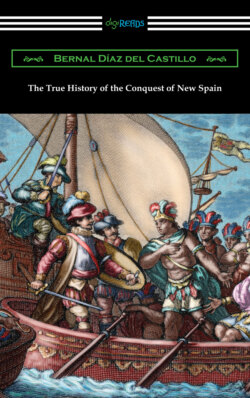Читать книгу The True History of the Conquest of New Spain - Bernal Diaz del Castillo - Страница 58
CHAPTER LII.
ОглавлениеHow Cortes erects an altar, and places thereon the image of the blessed Virgin with a cross; after which mass was said, and the eight Indian females baptized.
After peace had been restored between us, the caziques, papas, and other chiefs, Cortes ordered the fragments of the idols we had destroyed to be carried away and burnt. These orders were executed by six papas who came forth from a particular house, into which they carried the broken pieces and burnt them. The dress of these priests consisted in a long black cloak, white cassock, without sleeves, which hung down to the feet, and in a species of hood, which some wore greater, some less in size. Their dress was completely clogged together with blood, with which they were besmeared from head to foot, and impeded in their walk: they likewise smelt most offensively of sulphur and putrid flesh. We subsequently learnt that these papas were sons of distinguished personages. They were forbidden to marry, but were wholly given to unnatural offences, and fasted on certain days. Generally speaking, I never saw them eat anything else than the seeds of the cotton tree; they may, however, have partaken of other food for all I know.
When the idols were burnt, Cortes said everything that was edifying to the Indians by means of our interpreters. “Now,” he said, “we could look upon them as our true brothers, and lend them every powerful assistance against Motecusuma and the Mexicans, he having already acquainted the former that he was no longer to make war upon them, nor to exact tribute. Instead of their idols, he would give them our own blessed Virgin and Sainte, the mother of Jesus Christ, in whom we believed, and to whom we prayed, that she might intercede and protect them in heaven.”
The Indians listened with great good nature to this and many other things, which Cortes explained to them, concerning our holy religion. Every mason in the town was now set to work to bring chalk, which was in great abundance here, to clean away the blood from the walls of the cues, and plaster them well over. The day following this work was finished and an altar erected, which was covered with cotton cloth. The Indians were likewise ordered to bring a quantity of their splendid and sweet-scented roses with small branches of trees. Of these a garland was plaited, which was constantly to be renewed, that the place might remain pure and undefiled. Four papas were selected by Cortes to take charge of this; but their hair was previously shorn off, which they wore, as I have before remarked, very long and bristly; their dirty cloaks were taken off, and white ones put on, which, with the other part of their dress, they were in future to keep perfectly clean. In order, however, that they might have some one to look over them in their new occupation, Cortes nominated Juan de Torres, an old lame invalid of Cordova, to dwell near the altar, in the capacity of anchorite. The carpenters likewise made a cross which we erected on an elevated base, well plastered over with lime.
The next morning early father Olmedo said mass. A regulation was also made that in future the copal of this country should be used instead of our usual incense, and the inhabitants were taught to make wax candles from the wax of the country; of which, up to this moment, they had made no manner of use: these candles were always to be kept burning on the altar. The principal caziques of the district and village attended mass. But the chief ornaments there were the eight Indian females, who in the meantime had remained with their parents and relatives. These were now baptized after an edifying discourse had preceded the ceremony. The niece of the fat cazique, a very ugly woman, was named Doña Catalina, and presented to Cortes, who accepted her with every appearance of delight. The daughter of Cuesco, on the other hand, was most beautiful for an Indian female, and received the name of Doña Francisca, and fell to the lot of Puertocarrero. The six remaining young women, whose names I have totally forgotten, were given to some other of our soldiers.
The mass and baptismal ceremony being concluded, the caziques and principal personages took their leave, and from this moment the best feeling subsisted between us, for they were highly delighted that Cortes had accepted their daughter. We, therefore, returned to our new town Vera Cruz amidst the most joyous professions of friendship, and we shall soon see what happened there.
The good reader, however, may feel assured that nothing of any consequence further took place at Sempoalla than what I have related, and that herein Gomara and the other historians have completely erred.
